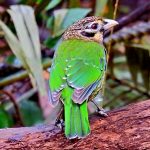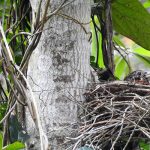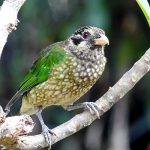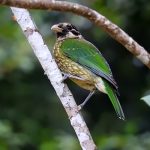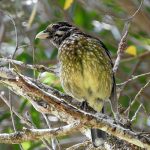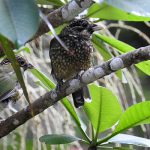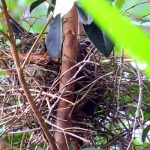SPOTTED CATBIRD
The Spotted Catbird is a medium-sized bird, adorned with a vibrant green plumage that allows it to blend effortlessly into the leafy rainforest canopy. Its upperparts are a rich, emerald green, while its underparts are lighter and speckled with white spots, resembling dappled sunlight filtering through the trees. The bird’s eyes are a deep, striking red, providing a sharp contrast to its green feathers.
The Spotted Catbird’s vocalisations are a key aspect of its identity, often being the first indication of its presence in the rainforest. These birds are renowned for their unique call, which closely resembles the meow of a domestic cat. This distinctive sound is not only used for attracting mates but also for establishing and defending territory. The calls can vary significantly, and individuals may develop unique “dialects” based on their location.
You can find the Spotted Catbird in the dense, tropical rainforests of North-eastern Queensland. These birds prefer areas with thick vegetation, where they can move through the canopy and undergrowth with ease. They are most often detected by their calls rather than sight, as their plumage makes them well-camouflaged among the foliage.
The breeding season for the Spotted Catbird runs from October to February. Unlike other bowerbirds that construct elaborate structures to attract mates, the Spotted Catbird relies on its vocal abilities. The female builds a simple, cup-shaped nest made of twigs and leaves, usually hidden within the dense foliage. She lays one to two eggs and is responsible for incubating them, while the male helps defend their territory.
Primarily frugivorous, the Spotted Catbird feeds on a variety of fruits, playing a crucial role in seed dispersal within its rainforest habitat. This dietary preference helps maintain the health and diversity of the ecosystem. This bird’s role in seed dispersal is vital for the regeneration of rainforest plants, highlighting its ecological importance. Occasionally, the catbird will also consume insects and small invertebrates, supplementing its diet with necessary proteins.
While specific lifespan data for the Spotted Catbird is limited, birds of similar size and habitat typically live between 5 to 15 years in the wild, depending on environmental factors and predation.

